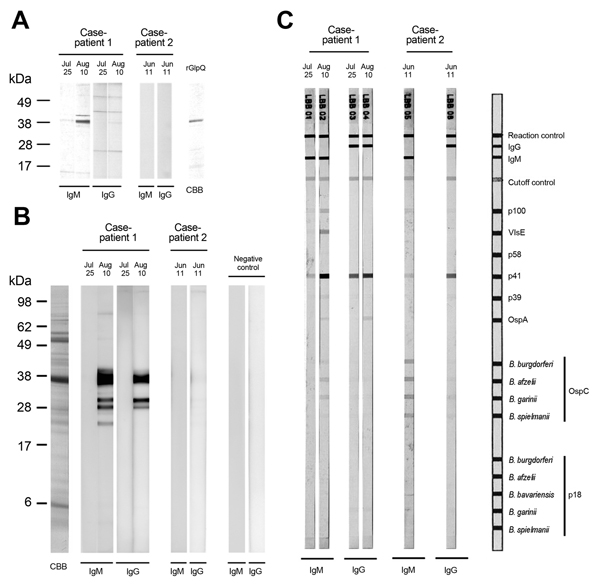Volume 20, Number 8—August 2014
Dispatch
Human Infections with Borrelia miyamotoi, Japan
Figure

Figure. Immunoblot analysis of serum reactivity to antigens of Borrelia miyamotoi and Lyme disease borreliae, JapanSerum samples obtained from 2 patients were examinedFor case-patient 1, acute-phase serum obtained on July 25, 2011, and convalescent-phase serum obtained on August 10 were usedFor case-patient 2, acute-phase serum obtained on June 11 was usedA) Reactivity to recombinant glycerophosphodiester phosphodiesterase (GlpQ) antigenCrude rGlpQ were used for immunoblot analysis (10)Recombinant GlpQ was separated by electrophoresis on a 5%–20% polyacrylamide gradient gel (Wako Pure Chemical Industries Inc., Osaka, Japan), and antigen was stained with Coomassie brilliant blueCBB, protein profileMolecular mass markers are shown on the leftB) Reactivity of patient serum samples to whole cell lysate of Bmiyamotoi antigensA low-passage strain of Bmiyamotoi (strain MYK3) was used for immunoblot analysis (10)A negative control was serum obtained from a healthy human (resident of an area to which Lyme disease was not endemic)Molecular mass markers are shown on the leftC) Serodiagnosis of Lyme disease by immunoblot analysis of serum samples from the 2 patientsOspC, outer surface protein C.
References
- Platonov AE, Karan LS, Kolyasnikova NM, Makhneva NA, Toporkova MG, Maleev VV, Humans infected with relapsing fever spirochete Borrelia miyamotoi, Russia. Emerg Infect Dis. 2011;17:1816–23. DOIPubMedGoogle Scholar
- Gugliotta JL, Goethert HK, Berardi VP, Telford SR III. Meningoencephalitis from Borrelia miyamotoi in an immunocompromised patient. N Engl J Med. 2013;368:240–5. DOIPubMedGoogle Scholar
- Krause PJ, Narasimhan S, Wormser GP, Rollend L, Fikrig E, Lepore T, Human Borrelia miyamotoi infection in the United States. N Engl J Med. 2013;368:291–3. DOIPubMedGoogle Scholar
- Chowdri HR, Gugliotta JL, Berardi VP, Goethert HK, Molloy PJ, Sterling SL, Borrelia miyamotoi infection presenting as human granulocytic anaplasmosis: a case report. Ann Intern Med. 2013;159:21–7. DOIPubMedGoogle Scholar
- Hovius JW, de Wever B, Sohne M, Brouwer MC, Coumou J, Wagemakers A, A case of meningoencephalitis by the relapsing fever spirochaete Borrelia miyamotoi in Europe. Lancet. 2013;382:658. DOIPubMedGoogle Scholar
- Fukunaga M, Takahashi Y, Tsuruta Y, Matsushita O, Ralph D, McClelland M, Genetic and phenotypic analysis of Borrelia miyamotoi sp. nov., isolated from the ixodid tick Ixodes persulcatus, the vector for Lyme disease in Japan. Int J Syst Bacteriol. 1995;45:804–10. DOIPubMedGoogle Scholar
- Taylor KR, Takano A, Konnai S, Shimozuru M, Kawabata H, Tsubota T. Borrelia miyamotoi infections among wild rodents show age and month independence and correlation with Ixodes persulcatus larval attachment in Hokkaido, Japan. Vector Borne Zoonotic Dis. 2013;13:92–7 . DOIPubMedGoogle Scholar
- Barbour AG, Bunikis J, Travinsky B, Hoen AG, Diuk-Wasser MA, Fish D, Niche partitioning of Borrelia burgdorferi and Borrelia miyamotoi in the same tick vector and mammalian reservoir species. Am J Trop Med Hyg. 2009;81:1120–31. DOIPubMedGoogle Scholar
- Takano A, Fujita H, Kadosaka T, Konnai S, Tajima T, Watanabe H, Characterization of reptile-associated Borrelia sp. in the vector tick, Amblyomma geoemydae, and its association with Lyme disease and relapsing fever Borrelia spp. Environ Microbiol Rep. 2011;3:632–7.
- Saito K, Ito T, Asashima N, Ohno M, Nagai R, Fujita H, Case report: Borrelia valaisiana infection in a Japanese man associated with traveling to foreign countries. Am J Trop Med Hyg. 2007;77:1124–7 .PubMedGoogle Scholar
- Hashimoto Y, Miyamoto K, Iizuka H. Tick bites and Lyme disease in Hokkaido, Japan [in Japanese]. Hihubyo Shinryo. 2003;25:926–9.